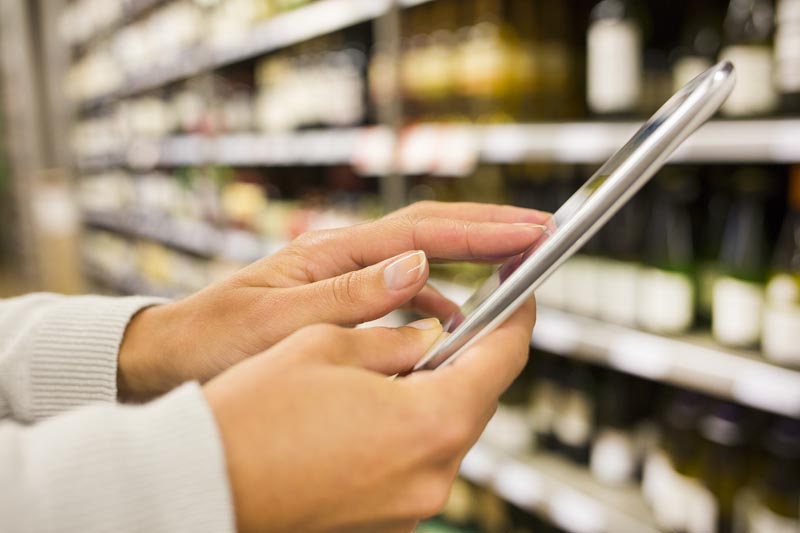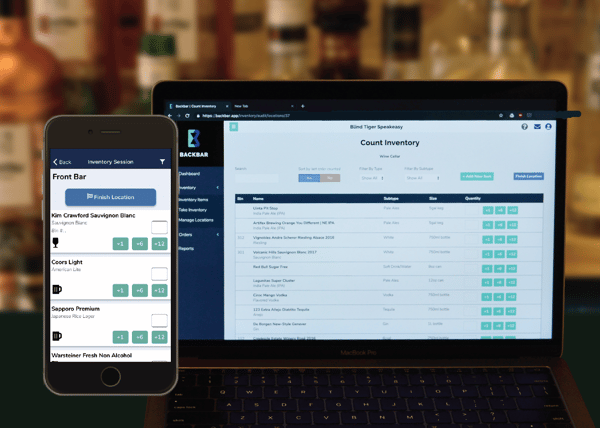Taking bar inventory can be time consuming and frustrating. It’s a lot of work to count hundreds of bottles, move boxes, punch numbers into spreadsheets and then analyze the data to make the work worth it. It’s important to have a consistent method for performing bar and liquor inventory that you can rely on to be quick, efficient, and add value to your business.
We’ll break down 5 things you can do to make managing bar inventory easier in your bar or restaurant. If you’re already using some of these strategies for liquor inventory, then you’re well on your way to earning more money from your bar program.
1. Organization is Essential
The first rule of inventory is staying organized.
What does ‘organized’ mean here? It means that every bottle should have a designated place to be stored.
Behind the Bar
Your best friend for staying organized is a label maker. Invest in one if you don’t already have one at your restaurant.
Use it to print labels to mark where each bottle in your bar goes. Make sure your bartenders and staff put bottles back in the right place after use. If you can, place labels on your backbar to mark where bottles go, as well as labeling the cabinets behind the bar.
Organizing bottles behind the bar is especially helpful if you have a house cocktail program.
You can group spirits together that are used in the same cocktails for faster use during service.
And each bottle will be in the right place when you take liquor inventory, so you don’t have to waste time searching for bottles behind the bar.
In Storage Areas
Organize your liquor storage areas so every bottle has a designated place.
You should group like-products together. Set up a shelf for your vodkas, a shelf for tequilas, a section for wines.
Make sure that when liquor orders are delivered each new bottle of liquor, beer, and wine is put in the correct place.
It’s not enough just to organize and assign each place. You’ll have to train staff to respect your new system of organization.
2. Setting up Your Bar Inventory Spreadsheet
Running a bar is a business, so you need to start thinking like an accountant when you put together your liquor inventory spreadsheets.
Mimic Your Bar Setup
Now that you’ve organized your bottles behind the bar and in storage, you can set up your inventory spreadsheet so each bottle is listed in the same order that it is organized in at the bar and in storage.
This will save you a ton of time because you won’t have to search for a bottle when you come to it on your spreadsheet, or vice versa. You can quickly go down your spreadsheet to mark the appropriate bottles and reduce the frustration of taking inventory.
Organize Inventory Spreadsheets by Location
Another great way to save time and stay organized is to setup your bar inventory spreadsheets by location.
For example, if you have multiple bars, you should create separate tabs in a spreadsheet like Excel for each location, eg., Bar 1, Bar 2, Back Bar, Front Bar, Wine Room, Beer Cooler, etc.
You can then organize each location in your spreadsheet to mimic the layout of your bottles for each individual location in your bar or restaurant. You can then set up a formula that will total your inventory counts from each location and give you a total count for each product.
3. Liquor Inventory Software
The downside of using spreadsheet programs like Excel for inventory is that they are awkward and clunky.
You often need more than one person to record inventory. And to make your inventory information useful, you need to be an expert on spreadsheet formulas if you want to analyze the data.
But there are much better services than Excel spreadsheets for taking bar inventory.
A quick google search for bar inventory software will tell you that there are a lot of inventory services available for bars and restaurants.
The important thing to look for is value. Will the service actually simplify taking inventory and save you time? And at what price? It’s important to do research to find the right service for you.
Many inventory apps and software provide a mobile friendly and easy-to-use interface for taking bottle counts, maintaining crucial organization, as well as providing reports that analyze the inventory data for you without the hassle of learning spreadsheet formulas.
Look for a system like Backbar that is simple to use so you can reduce inventory count times, get real value through inventory reports, allows you to place liquor orders with distributors, and is also is available at low costs.
Because alcohol sales are where restaurants can make the most money, it’s worth investing in an inventory system to make sure you’re maximizing the profits from your beverage program.
4. Reduce the Amount of Bar Inventory
This idea is really simple: The fewer bottles you have, the less time it takes to count them all, right?
It’s not enough to just count your bottles. It’s important to analyze your bar inventory so you know which items are bringing dollars into the restaurant, and which items are costing you profits.
Purging the items that don’t add value is a great way to help save time on inventory. It will also reduce your pour costs which means your bar program will become more profitable.
More money and less counting is a match made in heaven.
The bar inventory services referenced above are so useful because they give you an in-depth look at your inventory numbers. The inventory reports that a system like Backbar provides will help you analyze the inventory that you should get rid of.
Here are a few factors to consider when deciding what inventory you should stop carrying.
Bad Margins
Items with small margins generate less profit per sale. You want to sell items with big margins so each sale is more valuable.
Slowest Movers
Slow movers are inventory that don’t sell. Put slow moving items on special to sell down.
Quantity
If there is a product that you have too much of, but don’t sell regularly (maybe there was a great end-of-year deal on it) then it’s time to find ways to sell down your stock.
5. POS Integration for Bar Inventory

One of the most important terms you’ll come across when considering bar inventory is variance.
Variance, or shrinkage, is the difference between the inventory you have on hand and what the inventory should be based on your sales data. It is missing inventory that you did not sell. It could be theft. It could be over pouring. It could be a broken bottle.
It’s so important to track variance because that is money being taken from your pocket. You can track variance in spreadsheets, but it’s a lot of work. You will have to record a starting inventory at the beginning of the month (or use your last inventory counts), add in the purchases you made through out the month, and then take your closing inventory at the end of the month.
From there, you must cross-reference your inventory data with sales data from that period from your POS system. It’s a lot of work. But there is a faster way.
Updating inventory after sales gives you the information needed to identify where variance is hurting your business most, so you can take proper steps to address it. When you reduce variance you earn more money from your bar program.




